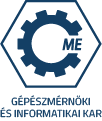| Course objectives: |
| Introducing the most important equations and approximation techniques describing the tribology behaviour of surface pairs in contact. Tribology analysis of journal bearings and gears, safety against seizure. |
| Course content and structure: |
| History of Tribology, Reynolds equation. Types of friction, different possible friction states between surface pairs in contact. Newton theorem, laminated flow, definition of viscosity. Difference between absolute and relative viscosity. Different possible ways to form the load bearing fluid film in journal and sliding bearings. Approximation used for the description of tribological state of gear surfaces, TEHD theory of lubrication. Calculation of most important characteristic temperatures in gearboxes. Safety against seizure concerning gear surfaces. The theory derived in the lectures is used during the practical lessons for numerical examples calculation of gears. |
| Evaluation method: |
| Test containing ten questions concerning the topics shown during the lectures and practical lessons. The maximum possible points of the test is 100. The exam will be closed by a 5- grade mark. Points 0-39: failed (1); points 40-54: passed (2); points 55-69: average (3); points 70-84: good (4); points 85-100: outstanding (5). |
| Required reading: |
| Neale, M. J.: The Tribology. Handbook, Oxford, 1995. Stolarski, T.: Tribology in Machine Design. Butterworth, Oxford, 2000. Merritt, H. E.: Gears. Sir Isaac Pitman & Sons, London Ltd. 1954. Thomsen, T. C.: The practice of lubrication. (an ngineering treatise). McGraw-Hill Book Company, New York, 1961. |
| Suggested reading: |
| Dudley, D. W.: Practical Gear design. McGraw- Hill, London, 1954. Valasek, I. (editor): Tribology parts 1. to 7. Tribotechnic KFt, Budapest, 2002. |


